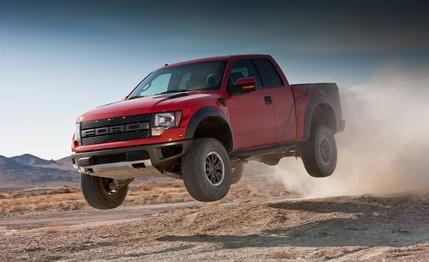 First Drive Review
First Drive Review
As the most radical off-road production pickup ever, the Ford F-150 SVT Raptor can teach a person a lot of things. On a dreary Michigan day, lessons flowed like the rivulets of runoff coursing through our backwoods driving loop at Ford’s Romeo proving ground. (O Romeo, Romeo! Wherefore art thou, Romeo? Just about an hour north of Detroit.) Lesson 1: Horsepower actually is man’s best friend. Lesson 2: Mud really does demand its own tire. Lesson 3: When life hands you a Raptor, sometimes you just gotta go nuts.
Lesson 1
Launched in 2009, the Raptor met with rave reviews everywhere it turned—or jumped, given its 11.2 and 12.1 inches of front and rear suspension travel, respectively. Our only complaint was the engine. Ford’s antiquated 5.4-liter V-8, with 310 hp and 365 lb-ft of torque, was adequate, but when the rest of the Raptor shines so brilliantly, “adequate” is as glaringly out of place as having Nickelback open for Mozart.
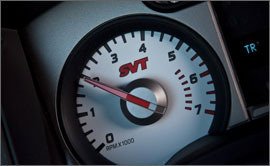
The optional 6.2-liter V-8, new for 2010, was in the plan all along, Ford tells us, and a quick turn behind the wheel seems to verify that. The character of this engine matches the truck perfectly. With 411 hp and 434 lb-ft of torque, it imbues the Raptor’s powertrain with the same unflinching capability as the long-travel suspension does the chassis. The Raptor’s 6.2 is structurally identical to the 6.2-liter in the 2011 Super Duty lineup, but its output is higher than the SD’s 385 hp and 405 lb-ft, thanks to unique cams and tuning.
Although our slog through muddy Michigan woods didn’t give us the chance to experience the high-speed off-road stability demonstrated by the truck’s desert introduction, it proved that horsepower is helpful everywhere, and at much lower speeds than the truck’s sand-scorching limits. Whether you’re powering up a slippery slope or powersliding through a gravel autocross, the 6.2 commands the truck with far greater authority than the 5.4-liter. The conditions this truck was conceived to conquer require the throttle frequently be used for directional control, and the bigger engine meets those demands every time.
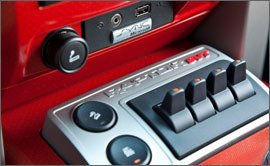
Lesson 2
Well, maybe not every time. A spring deluge removed a critical component from our drive of the more powerful Raptor: steering input. So slick and soft were the muddy trails that we ended up enslaved by the goopy ruts the lead truck carved, obeying them like a train powerlessly following its tracks. We could have removed our hands from the wheel and followed the lead truck just as faithfully.
SVT engineers explained that the BFGoodrich All-Terrain rubber selected for the Raptor is the best compromise they could find between on-road behavior and various off-road conditions—desert sand, boulders, loose sand, snow, mud—but it’s weakest in mud. Compared to a dedicated mud tire, the small and tightly spaced tread blocks too easily pack with gunk just as slick as the surface on which you are driving. Imagine the traction of driving on wet ice with tires made of wet ice, and you’re remarkably close. At one point on a narrow trail surrounded by dense forest, we slid completely sideways down a steep grade for about 10 feet before a bump snagged the rear of the truck and the nose swung around, narrowly avoiding a tree before we matted the throttle to climb up a hill between two tightly spaced trees.
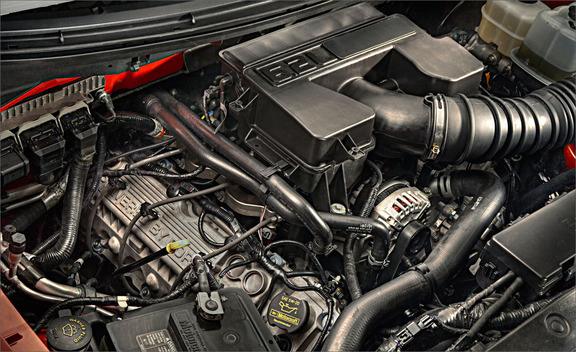
Later, out in the open on a higher-speed dirt—now mud, of course—track, a truck wearing chunky mud tires proved the superiority of such rubber in those conditions, easily ripping its way out of existing ruts and powering down the straights 10 mph faster than the stock-tired trucks. The SVT team said that, despite the obvious benefit in our conditions, the mud tire is too much of a compromise in anything else. We didn’t have the chance to experience that tire on-road ourselves, but looking at those big, soft tread blocks and imagining their frightening capacity for deformation had us nodding in agreement. Still, Midwestern buyers of the Raptor will seriously want to consider owning a set of mud tires.
Lesson 3
Away from the muck and mire, we proceeded to our next challenge: a gravel autocross that provided the day’s best opportunity to experience the throttle-steering abilities of the 6.2’s 411 hp. Every driver in our group looked like a rally champion tossing the Raptor through the cones of the handling course, and the broad power band of the new engine made it simple to link multiple turns in one gratuitous pendulum swing of gravel-slinging glory.
Also helping even the chumps look like champs was the extreme leeway allowed by the stability-control system’s sport mode, which is engaged at the first push of the stability-control button, when traction control is disabled. The threshold for intervention is exceedingly high, allowing yaw rates that had us forgetting any electronic aids were still on. To turn the system fully off, hold the button for eight seconds, and release, although you never need to do this. Well, almost never. In the greasiest mud, momentum is to be conserved no matter which direction it’s carrying the truck. If there aren’t any trees to hit, we learned it’s better to careen off the course rather than risk slowing down. In Michigan muck, it turns out there are a lot of ways to get stuck.
A Winning Partnership
As brilliant as the 5.4-liter Raptor is off-road, laziness is its worst on-road habit. With a truck weighing 6000 pounds and an engine producing barely over 300 hp, that’s inevitable. Not so with the bigger motor. In our testing, the smaller engine lugged the truck to 60 mph in 8.0 seconds. Expect the 6.2 to drop that time to somewhere around 7.1 seconds. Not only that, but the roar from the new mill is fantastic, as stirring as the powerboat soundtrack of the Cadillac Escalade’s 6.2-liter V-8, but without the novelty of being so exceedingly out of place. Depending on how you look at it, that can be a positive or a negative. Our lone complaint about the Raptor is that, for truly hectic off-road dashes—so, all of them in fact—the transmission could use paddle shifters or some form of manumatic control for better ratio management.
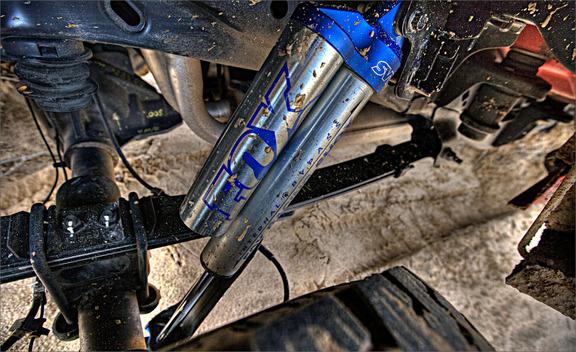
Although hardly a drag racer, the Raptor 6.2 had nobody asking for more power. The SVT guys tell us we do not need more power and that we don’t actually want more, either. Too much, they say, and the Raptor would run a much higher risk of snapping axles and otherwise munching itself. We’d say that sounds like loser talk if we weren’t so completely satisfied with the truck and this new engine. Its $3000 premium over the base engine—bumping the base price from $38,995 to $41,995—shouldn’t deter anyone. The 6.2-liter V-8 is the most essential of all Raptor options.